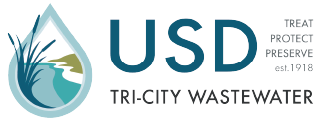Local Limits and Fee Schedule
Industrial Permit Fee Schedule
Local Limits (For a printable copy, click here)
Sewer Use Ordinance No. 36, Section 2: No person shall discharge wastes into the sanitary sewer which exceed the following limitations on wastewater strength:
|
Pollutant |
Limit for any 1 Sample |
EPA |
|
|
Arsenic |
0.35 mg/l |
200.7 |
|
|
Cadmium |
0.2 mg/l |
200.7 |
|
|
Chromium (T) |
2.0 mg/L |
200.7 |
|
|
Copper |
2.0 mg/l |
200.7 |
|
|
Lead |
1.0 mg/l |
200.7 |
|
|
Mercury |
0.01 mg/l |
200.7 |
|
|
Nickel |
1.0 mg/l |
200.7 |
|
|
Silver |
0.5 mg/l |
200.7 |
|
|
Zinc |
3.0 mg/l |
200.7 |
|
|
Cyanide |
0.65 mg/l |
335.4 |
|
|
Formaldehyde |
50.0 mg/l |
6252.B·/8315 |
|
|
Oil and Grease (Animal &Vegetable) |
300 mg/l |
1664 A |
|
|
Oil and Grease (Mineral) |
100 mg/l |
1664 A |
|
|
pH |
Between 6.0 and 12.0 |
150.2 |
|
|
Phenols |
5.0 mg/l |
604/625/420.1 |
|
|
Temperature |
No higher than 150°F |
2550B· |
|
|
Total Toxic Organics1 |
2.13 mg/l |
624/625 |
|
| Ammonia2 | Avg. Flow <10,000 gpd | 225 mg/L as N | 350.1 - 350.3 |
| Avg. Flow 10,000 – 25,000 gpd | 150 mg/L as N | ||
| Avg. Flow >25,000 gpd | 75 mg/L as N | ||
|
· Standard Methods Number + Test methods listed are examples. Analyses must be performed using Approved Methods listed in Code of Federal Regulations 40 (CFR) 136. 1 Total Toxic Organics (TTO’s) is the summation of all quantifiable values greater than 0.01 milligrams per liter for the organic pollutants listed below. |
Prohibited Wastes Include:
- Flammable or explosive substances
- Highly toxic and poisonous substances
- Substances which may obstruct flow
- Strongly odorous wastes
- Uncontaminated water (such as one-pass cooling water, storm water runoff, etc.)
- Sludges
- Wastes with temperatures over 150o F
- Most radioactive wastes (in excess of State Guidelines)
- Wastes which contain or result in the production of toxic, corrosive, explosive, or malodorous gases
- Organic solvents (including halogenated solvents) in excess of TTO limits.
For a complete list of prohibited wastes, see District Ordinance No. 36.
Total Toxic Organics (TTO’s) is the summation of all quantifiable values greater than 0.01 milligrams per liter for the following organic pollutants:
|
Volatile Organics (624)
|
Semi Volatile Organics (625)
|
For additional information on Industrial Discharge Requirements, see Ordinance 36.
Click link to view all USD Sewer Use Ordinances.

